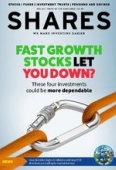Archived article
Please note that tax, investment, pension and ISA rules can change and the information and any views contained in this article may now be inaccurate.
How decades high US inflation and new ECB direction are leading to market turmoil

Economic data and central bank decisions are proving pivotal for markets and are setting the stage for a potentially difficult time for shares and bond investors alike over the rest of the summer.
The ECB (European Central Bank) on 8 June signalled lift-off for higher interest rates at its July meeting and even hinted that half a percentage point rate hikes might be necessary to tackle decades-high inflation.
The euro initially gained against the US dollar and the pound, but those gains were temporary and soon evaporated after news (10 June) that US inflation came in hotter than expected to reach 8.6% in May, the highest since December 1981.
US bonds and the dollar moved higher on the data demonstrating a growing belief among investors that the US Federal Reserve may need to move more aggressively than previously thought.
The best indicator of where investors believe interest rates are headed is to look at US two-year Treasury yields. They have gained 0.45 percentage points to 3.25% since the inflation print and are up 0.6 percentage points since the start of June.
This implies investors are anticipating more aggressive interest rate hikes from the Fed and possibly a larger move than the half a percentage point the Fed has guided for the next two meetings. (This article went to press before the latest decision on 15 June was known).
VOLATILITY MOVES HIGHER
The so-called fear gauge, or Vix index, has moved back above 30, indicating investors are pricing in 2% daily moves in the S&P 500 index over the next month. For context the Vix moved above 60 in March 2020 at the height of the Covid sell-off.
The S&P 500 briefly looked like it would avoid a bear market – defined as a 20% loss from the peak – but is now sitting in bear territory.
Growth stocks are more interest rate sensitive and that makes them vulnerable in a rising rate environment. The Nasdaq 100 index has dropped 11.5% over the last five days and is nearly a third below the peak reached in November 2021. The technology focused Scottish Mortgage (SMT) is down 13% on a five-day view.
Speculative and risky assets like cryptocurrencies have also been out of favour, with bitcoin, having stabilised around the $30,000 level, dropping a further 25% since the US inflation data came out.
Investors looking to hide from the turbulence have historically relied upon all-weather funds and trusts designed to preserve capital. For example, capital preservation specialist Ruffer Investment Company (RICA) is up 0.6% in the wake of the shock on US prices.
Important information:
These articles are provided by Shares magazine which is published by AJ Bell Media, a part of AJ Bell. Shares is not written by AJ Bell.
Shares is provided for your general information and use and is not a personal recommendation to invest. It is not intended to be relied upon by you in making or not making any investment decisions. The investments referred to in these articles will not be suitable for all investors. If in doubt please seek appropriate independent financial advice.
Investors acting on the information in these articles do so at their own risk and AJ Bell Media and its staff do not accept liability for losses suffered by investors as a result of their investment decisions.
Issue contents
Education
Funds
Great Ideas
- Fulham Shore is navigating cost pressures well and continues to expand
- Buy shares in Photo-Me for its underappreciated earnings potential
- Watches of Switzerland's shares have fallen too far, buy them now
- Don't worry about slowing orders at Chemring as it looks well placed
- Cheniere Energy outperforms the global stock market
- Still plenty of reasons to want to invest in this property expert
News
- Apple’s push into advertising poses challenges for Meta, Alphabet and Snap
- Airline shares dive amid prospect of high compensation costs
- Why shares in Primark parent Associated British Foods are languishing near five-year lows
- How decades high US inflation and new ECB direction are leading to market turmoil

 magazine
magazine








